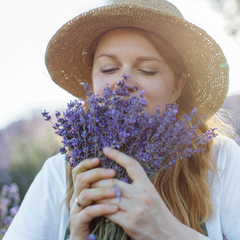
1. Inhalation

Some fancy science for you 👩🏻🔬
Scientists from the Institute of Pharmaceutical Chemistry in University of Vienna proved that inhaling essential oils is a very efficient way for getting its benefits [3]. They credited the nasal mucosa for excellent absorption comparable to intravenous injection within a short period of time.
In other words, inhaling and injections take roughly the same time for the product to work!
Diffusers and humidifiers are great for dispersing essential oils into the air. The smell would fill up the room and create a very pleasant experience. Plus, they can be a really beautiful addition to a room.
If you are in need of some relaxation, diffuse some lavender in your home. The lavender essential oil molecules enter through your nose and reach both your brain and lungs. These molecules will send signals to your brains, telling it to lower your blood pressure and increase your oxygen intake.
As a result, you will feel a lot calmer and relaxed. Wouldn't it be amazing to smell lavender at every corner of the house and chill?
More fancy science for you 👩🏻🔬
Every essential oil has a unique scent. They represent different patterns of spatial activity in the olfactory bulb [4].
So if you wanted to perk up, you could inhale peppermint instead as it is a stimulating oil.
Inhalation is a very common and preferred way to use essential oils. Because it does not need much preparation. You can drop a few of your favourite oils into the diffuser and you're set!
Within moments, the wonderful scents will fill up your home. Creating an atmosphere delighting your senses! It's also the best way of sharing the benefits of essential oils with everyone in the house.
Tip #1 If you or someone at home is down with flu. Diffuse some minty essential oils such as peppermint to help clear the nasal passage. You'll get to breathe and sleep better for a faster recovery.
Tip #2 After you've done spring cleaning. Diffuse some citrus oils such as orange and lemon or even tea tree to bring an uplift into your home. So it's always smelling fresh and clean.
It's important to note that essential oils are sensitive to heat and light. So, the best way to store essential oils are in cool and dry places.
This is the reason many avoid using essential oils in the bathroom (since its usually hot and damp). But, you can still find a lot of uses for them in there.
Tip #3 You could add a few drops of essential oils to your shampoo, conditioner, and body wash. Now you can enjoy the benefits every shower 🤗
Tip #4 You can inhale these essential oils while you shower too. Add a few drops to the shower walls and take a deep breath in. Another way would be to add a few drops of diluted essential oil to a warm washcloth. You can inhale this and use it to exfoliate your body.
Tip #5 You'll love this if you enjoy taking baths. Dilute a few drops of essential oils with a carrier oil before adding it to your bathwater. Now, you can have a nice, relaxing soak after a tiresome day.
2. Ingestion

So, it seems logical that it should work for a plant-based substance. Especially when it comes from the food we usually eat, right? Well, not exactly.
While it is possible to ingest essential oils, this should be done in very small quantities [5] and under the care of trained professionals. It is very important to note that these oils are volatile and potent [6].
Dr Yufang Lin, MD, is an integrative medicine specialist and advises against the consumption of essential oils. “I do love aromatherapy,” Dr. Lin says in an interview by wellandgood.com. But, “I usually caution people against taking it orally is because it’s a really strong medicine…You can take too much, too quickly without realizing it. And that can become toxic.” [7]
As we were formulating our balms, we had direct contact with pure essential oils. Well, we can assure you that it stings! And that makes us think twice about putting them into our body especially when we can't wash them off as easy.
It's even more horrific to hear experiences such as the Stacey Haluka case.
Stacey has been ingesting essential oils after she was assured that these oils are pure, hence good for her. But, it soon made her body covered in blisters until she decided to seek proper medical attention. You can learn more about Stacey's case as Netflix featured her in the series "(Un)well".
We understand that it is easy to confuse natural and safe. If something is plant-based and chemical-free, one can assume that it is safe to eat. But, we should not take essential oils lightly especially when your safety could be at risk.
You should consult a trained medical professional if you're interested in this method. Otherwise, we would advise to avoid oral ingestion and internal application such as the mouth.
3. Topical

How to do a skin patch test?
1. Pick an area of your skin to do the test. The skin around the crook of your elbow is a good place for a test.
2. Ensure the skin patch area is clean and dry.
3. Apply a small amount of product on that area for 24 hours.
If there are no reaction, you may continue using the product. If your skin turns red or start to itch, wash off immediately. If redness, itch and rash persists, please consult your doctor.
Disclaimer
The article written represents the writers' opinions based on their findings. It is not meant to be expert/medical advice. Users are solely responsible for fully understanding the safety and risks of essential oils.
Reference
[1] - Shaaban, H. A., El-Ghorab, A. H., & Shibamoto, T. (2012). Bioactivity of essential oils and their volatile aroma components. Journal of Essential Oil Research, 24(2), 203-212.
[2] - Djilani, A., & Dicko, A. (2012). The therapeutic benefits of essential oils. Nutrition, well-being and health, 7, 155-179.
[3] - Buchbauer, G., Jirovetz, L., & Jäger, W. (1991). Aromatherapy: evidence for sedative effects of the essential oil of lavender after inhalation. Zeitschrift für Naturforschung C, 46(11-12), 1067-1072.
[4] - Shepherd, G. M. (2006). Smell images and the flavour system in the human brain. Nature, 444(7117), 316-321.
[5] - Park, B. J., Morikawa, T., Ogata, T., Washida, K., Iwamoto, M., Nakamura, H., & Miyazaki, Y. (2009). Physiological effects of ingesting eucalyptus essential oil with milk casein peptide. Silva Fenn, 43, 173-179.
[6] - Orchard, A., & van Vuuren, S. (2017). Commercial essential oils as potential antimicrobials to treat skin diseases. Evidence-Based Complementary and Alternative Medicine, 2017.
[7] - Girdwain A., (2019). Well + Good. Holistic Treatment: Is It Safe to Ingest Essential Oils? An Aromatherapist and an MD Weigh In, 2019.
[8] - Feldmann, R. J., & Maibach, H. I. (1970). Absorption of some organic compounds through the skin in man. Journal of Investigative Dermatology, 54(5), 399-404.

